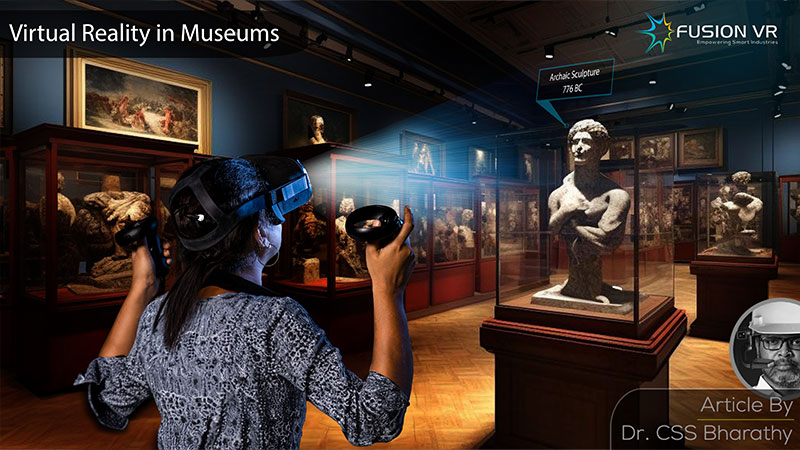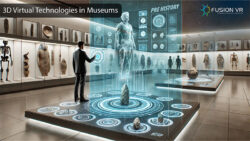Virtual reality is virtual, not real, but almost real.
Think about it! Is it possible to be in someplace that was in the past? The realistic answer is no, while the virtual reality answer could be yes. Virtual reality is helping to recreate experiences that feel really real about anything that you missed or considered impossible. Museums have been an excellent gateway into the past. As we enter museums and wander through the corridors, we are bound to get the feeling of being in a time long gone. The ancient objects and the imagery enveloping you makes you feel as though you’re in a different realm, at least in your mind. That feeling of being in another world and time is what virtual reality technology for museums strives to deliver.
Museums play an invaluable role in our lives, though we may not actually realize it. They are instrumental in preserving our history, culture and its treasures. It also helps to sustain the identity we have built or created for ourselves as a society or nation. This is helpful in creating cohesiveness in our society with a vision of a shared past and enabling a shared vision for the future. What would we do if we don’t have museums to help us with that. Museums have grown much broader in their role. They are not just the curators of national treasures. Museums have grown to cater to any aspect of our lives that is worth sharing and preserving. Museums have also become places to share the unpleasant events of the past, so that such events are not repeated in the future. They are also a place to treasure the sacrifices of the past so that they are not forgotten by future generations to come. Unfortunately, with the growth of technology, there is a perceptible decrease in the number of visitors to museums. This is a concern and one that can be solved by resorting to, yes, technology. But how?
The answer lies in the adoption of virtual reality technology and augmented reality technology in museums. The undeniable truth is that the future of museums is with virtual reality and its effective integration with the existing exhibits and artifacts. You will begin to see why the previous statement is so true as you read further along. The scope of traditional museums would expand a lot with the use of virtual reality.
There are many aspects of our history and culture that can be brought to life with virtual reality exhibits. There are many virtual experiences that help us appreciate and enjoy the wonders of the world around us. There are many who may not be blessed with resources and the ability to travel places to enjoy the best museums out there. By implementing a VR experience center in a museum, the visitors experience is highly enhanced. For all these reasons and more, there is virtual reality and its ability to level the playing field for everyone who appreciates and enjoys the wonderful world of a museum.
Many of us have seen and heard about the Mona Lisa. Some of you may not be aware that it is in the Louvre, in Paris, France. The painting is about five hundred years old and it’s amazing that it has survived till this day. To visit this museum from India would mean a significant expense for the average Indian. Moreover, you have to brave the crowds to get a good look and that may not enable you to appreciate and enjoy the beauty of the painting by Da Vinci. While we all want to appreciate the painting, the reality is that we may not be able to. The Louvre launched a VR experience called Mona Lisa – Beyond the Glass. It enabled visitors to discover the amazing details of the painting, its creation and how it has changed the way it looks over the many years since its creation. It provides the experience of being in the Louvre and enjoying it up close and personal. The resulting level of appreciation is impossible in a regular visit. The experience is accessible to all with absolutely no cost. All they need is a device and connectivity to download it and experience the Mona Lisa masterpiece.
Apart from getting up close to an amazing painting, it is also possible to virtually get inside one! That seems to be a stretch, but it is possible with virtual reality. Let’s hop from France to Finland and look at the virtual reality exhibit in the The National Museum of Finland. Located in Helsinki. The museum’s VR exhibit takes a visitor back in time to the year 1863 and explores a popular R. W. Ekman painting called The Opening of the Diet 1863 by Alexander II. This exhibit immerses the visitor providing the feeling that they are stepping inside the painting and looking around the characters around them. The experience is made unbelievably realistic by allowing visitors to even speak with the characters depicted in the painting, providing a glimpse of Finnish life and politics in the 1860s when it was under the Russian Empire. This particular;y unique experience cannot be obtained otherwise without virtual reality and underscores why I claimed a few paragraphs before that the future of the museum lies with virtual reality. The VR museum experience will be quite unforgettable due to the immersiveness of virtual reality.
More unique experiences can be created using virtual reality. To better understand and appreciate national icons and events of national importance, we can resort to conventional storytelling or try virtual reality. Who wants to witness the carnage of the Kalinga war beside Ashoka the Great and hear from him his account of how that experience changed his mind. Does anyone like to go on a voyage across the Bay of Bengal along with the Chola navy as he conquers far flung kingdoms in South-East Asia. Another experience is to scale the Pyramids of Giza, enter the gardens at the Taj Mahal and view the grandeur of it or witness the depths of the Grand Canyon. This list is endless for anyone who wishes to explore the wonders of the world.
These are interactive museum experiences that virtual reality developers and artists will gleefully create for the visitors to obtain an experience of a lifetime. It is true that to create such experiences, a cross functional team of developers, artists, historians, actors, project managers etc. are required. It is also true that the virtual reality experience could be expensive to create. The positive aspect of the cost and effort behind virtual reality exhibits is the quality of experience that it provides. It’s often an individual and honestly, a very personal experience for many. As the adoption of virtual reality technology increases, the cost of development and implementation will reduce. This is evident in the growth of the VR gaming industry which led to reduction in device costs. This made it more affordable for people to buy headsets across the world. I foresee a similar experience with VR for museums and corporate experience centers.
The use of technologies in museums is growing with more government support and involvement. Fusion VR is a pioneer in India and has been at the forefront of implementing VR museum solutions across the country. The uniqueness, educational and recreational value it has demonstrated in its museum projects is there for all to see. To learn more about digital museums and corporate experience centers, please visit the dedicated page on our website and step into a completely immersive virtual reality realm to enjoy this unique experience.





